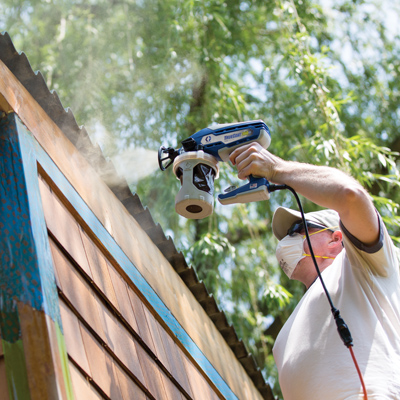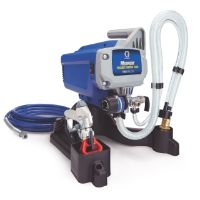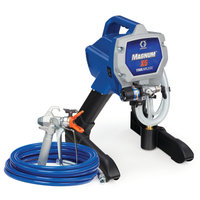How To Paint a Shed Using a Paint Sprayer
Project Overview
Sheds are great for storage. Just like your house, your shed can fade over time. Graco sprayers make it easy to freshen its appearance with a new coat of paint or stain.
Safety Notice: Whenever operating spray equipment, take proper safety precautions, stay alert and be mindful of potential hazards. Wear protective gear such as gloves, safety glasses/goggles, spray sock (hood), hat, proper footwear, dust masks and respirators. Make sure there is adequate ventilation. If you’re painting in the vicinity of appliances, turn them off. (See Safety Precautions in your Sprayer Operation Manual.) Always refer to the specific instructions and safety procedures for the spray equipment you are using.

Suggested Tools & Equipment
- Graco, Magnum, or TrueCoat Paint Sprayer (visit Paint Sprayer category page to compare models)
- Paint/Stain
- Spray tips – a wider spray pattern for large surfaces and narrow size for smaller surfaces (see tip selector)
- Empty buckets for priming sprayer and clean up (two needed)
- Stirring sticks
- Paint strainer bag – helps prevent tip plugs and provides a better finish
- Tarps, drop cloths, or plastic sheeting
- Masking tape
- Paint brush for touch-ups
- Magnum tip extension (optional) – for hard-to-reach areas that would otherwise require a ladder
- Additional airless hose sections if needed
- Spray shield
- Pump Armor storage fluid (see pump protectant product details)
- Cleaning rags
- Stiff nylon brushes for clean up
Getting Started/Prep
- Move any decorative items away from the shed. Remove any bird nests or other debris; then use a pressure washer and cleaning solution to clean away any dirt, mildew or mould that has accumulated on the shed’s surfaces. Allow surfaces significant time to dry.
- Remove any hardware such as door handles. Scrape off any peeling paint, and repair any damaged siding, eaves or trim. Drive any loose nails flush. Sand any rough surfaces and caulk gaps as needed.
- Tape off/mask any trim, and cover any surfaces such as windows that you don’t want sprayed with plastic. Use plastic drop cloths to cover any shrubs or bushes as well.
Spraying
- Select the spray tip(s) that's best suited for the paint you are using and the surface to be sprayed- a wide fan pattern is best for walls, while a narrower 20 cm fan pattern is best for trim and other narrower areas. Be sure the tip's hole size does not exceed the maximum capacity of your sprayer (see spray tip info). If you're using paint from multiple containers, mix it together in an empty 20 litre container to ensure consistent colour even if small colour differences exist between individual paint cans.
- If you don't have a lot of spraying experience, choose a flat surface such as the back of the shed that won't easily be seen to begin on. Start at the top of the area and work your way down, first spraying any eaves or undersides of any overhangs. The direction you will spray depends on the construction as a general rule, spray any exposed trusses, wood beams, or boards by aiming the spray fan pattern to follow lengthwise.
- Work in sections only as far as you can comfortably reach, keeping the spray tip approximately 30 cm from the surface. (A tip extension is a useful accessory, as it will allow you to safely spray hard-to-reach areas such as eaves or other overhangs). Spray the outer edges first, "banding" the area that you will spray. For inside corners, aim the spray tip directly into the corner so that the spray fan overlaps both sides. Overlap your spray passes by 50%.
- After you have completed the eaves, spray the exterior walls themselves. Cut in around windows and doors first, and then spray the remaining flat areas, overlapping each pass by 50%.
Clean Up
- Allow significant time for the paint or stain to dry before removing tape from your trim. This will result in crisp, clean lines.
- Remove all coverings from shrubs, bushes and plants. Carefully remove all tape and plastic covering from window and door trim.
- Replace any hardware such as door handles, lock hasps or hinges that you removed.
- Clean your airless paint sprayer after each use. Follow the directions in your user’s manual for Power Flush cleaning with water based materials or use the bucket method of cleaning if applicable. For more information, see Power Flush Video or refer to your Sprayer Operation Manual.
- Return any other decorative items to their proper place.
Related Projects
Outdoor Furniture
Whether it’s a flea market find or a special chair you already own, a fresh coat of paint can give new life to outdated or tired-looking furniture.
Shutters
With a fresh coat of stain or paint, decorative shutters greatly improve your home's curb appeal while preserving and protecting them from sun and weather damage.
Railings
Railings take a lot of abuse. Keep them looking their best with a fresh coat of paint or stain to preserve and protect them from the sun and weather.




